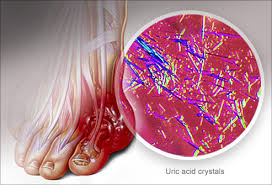
Tophaceous Gout: What Are Tophi and How Can You Treat Them?
Gout is an often painful but common condition. It occurs when urate crystals accumulate in the joints, like those in the hands and feet. Gout is unpleasant to deal with on its own, but it comes along with additional symptoms, including tophi (singular: tophus). Although tophi aren’t typically painful on their own, they can become inflamed and swell, which can add to your discomfort. Here’s an overview of what tophi are, why they develop, and how they’re treated.
What Are Tophi?
Tophi are a symptom of gout – they are the bulbous, swollen growths that appear under the skin around joints. They occur when uric acid crystals build up near the joints. They happen specifically in advanced gout, when the deposits of urate crystals go untreated. Tophi are generally not painful, but they can become tender during a gout attack.
You might see tophi appear in many places around the body, but they commonly pop up around joints. This could be on your hands, fingers, elbows, feet, and back of the ankles.
There are certain types of tissue where uric acid builds up most often, leading to the formation of tophi. This includes:
- Cartilage around the joints
- Tendons that connect the muscles to joints
- Soft tissues in the joints, including ligaments and fat
- Synovial membranes along the joint cartilage
- Sacs of tissue (called bursae) that act as a cushion between bones
In some cases, tophi can form inside connective tissue that isn’t near a joint. This includes the whites of the eyes, heart valves, kidneys, and ears.
What Causes Tophi to Develop?
There are four stages of gout and tophi only develop in the final stage. The stages of gout are:
- Asymptomatic hyperuricemia: There’s an excess of uric acid in the blood but no symptoms.
- Acute gout: Uric acid begins to build up and crystalize in a joint, creating inflammation, warmth, and pain. This is a gout attack.
- Interval gout: Between gout attacks, there are symptomless stages called interval gout. This stage can last anywhere from days to years.
- Chronic tophaceous gout: Tophi develop when gout goes untreated for an excessively long time – about 10 years. They can develop in the joints and nearby tissues.
Symptoms of Tophi
Although tophi are a symptom of gout, they have their own symptoms, as well. Initially, they aren’t painful. However, they can become inflamed and swell, which then creates pain and discomfort.
A tophus can stretch out the skin, making the area feel tight and uncomfortable. At times, this can cause painful sores and the tophi may even break the skin. The wound can then release a white material that is composed of hardened uric acid. Over time, tophi that are left untreated can break down joint tissue, which results in a twisted appearance and pain in the joint.
It’s also worth noting that you may experience a gout attack simultaneously with tophi. In this case, you might feel warmth, swelling, and tenderness around the tophi. The joint may be painful to use for days after the initial attack ends. Left untreated, you can also lose some of your range of motion in that joint.
Diagnosis for Tophi
A doctor can confirm the existence of tophi by appearance, lab tests, and imaging. Tophi look twisted and gnarled to the eye, which may require a lab test to confirm before diagnosis. The tophi can be aspirated and some of the tophaceous material can be removed and analyzed in a lab under a microscope.
In some cases, CT or MRI scans may be needed to analyze larger tophi. These tests allow the doctor to determine what damage has been done to the cartilage, bones, and joints.
Treatment for Tophi
To avoid the most adverse symptoms, especially damage to the joint and tissue surrounding tophi, it’s important to seek treatment. Treatment is typically part of a comprehensive plan to treat gout, which can involve lifestyle changes and medications.
Smaller tophi will likely have no impact on your range of motion and may be treated with changes to the diet or medications. These tophi are also less likely to become inflamed and painful. With larger tophi, surgical removal is often best. This can protect the joint from any further damage or loss of range of motion.
Doctors can also prescribe medication to lower the levels of uric acid in the blood to levels at which tophi will dissolve – 5 mg/dl. These drugs are:
- Aloprim (allopurinol)
- Benemid (probenecid)
- Krystexxa (pegloticase)
- Uloric (febuxostat)
If you’re experiencing this condition, it’s best to see your doctor right away. Remember, gout and tophi left untreated can have irreversible damage. You might also consider a clinical trial to treat your gout, including the pain and swelling that often accompanies it. Taking part in a study allows you to get access to cutting-edge treatment and aid in the advancement of medicine. Read more about the study with Triad Clinical Trials here.

